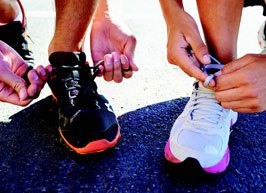
Athletic stores are filled with shelf after shelf of shoes designed for running—enough to make your head spin. But how do you know which shoe will be best for you? Do you take the salesman’s recommendation, or do you consult a professional? How do you know whether one brand of running shoes is really better than another, orthopedically?
There are two basic shoe-and-running-style combinations, each with its strengths and drawbacks.
- The first style is the traditional, cushioned, relatively structured running shoe. While wearing these, most runners use a heel-to-toe motion, known as a rearfoot strike pattern. Rearfoot strike running appears to be associated with certain injuries, including tibial stress fractures, plantar fasciitis and soft tissue problems of the lower extremity.
- The second style, either a minimalist or “barefoot” shoe, encourages two other running patterns: forefoot or midfoot strike. These running shoes have less cushioning, thinner soles and more flexibility overall.
A recent study in the Journal of the American Academy of Orthopaedic Surgeons shows that while all kinds of runners suffer traumatic injuries at about the same rate, forefoot strike/midfoot strike runners are 1.7 times less likely to suffer repetitive injuries. However, forefoot strike/midfoot strike runners in “barefoot” shoes may more likely end up with toe stress fractures and puncture wounds, and they can develop plantar fasciitis as well.
The journal review suggests that there is a tentative edge to forefoot strike/midfoot strike over rearfoot strike but stresses that it’s most important that you not switch abruptly from one running style to another. Such a shift requires real training, as though you are starting out as a new runner. In addition, you can run forefoot strike/midfoot strike in traditional shoes if you like—it just takes practice.
The 1960s adage “Do whatever feels good” applies to today’s runners, as well. Research indicates that shoes that feel the most comfortable, both when you run in them and when you wear them just to walk around, are those in which you’ll be least likely to suffer injury.
No matter what your goals, we’ll be happy to analyze your running pattern and help you select a pair of shoes that is right for you. We can also create a new running plan for you or modify your current training plan to reduce your risk of injury and maximize your enjoyment and fitness.
